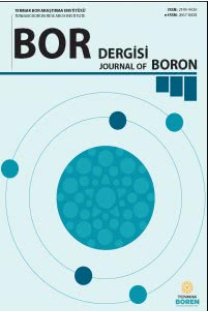Bor Nitrür ile kaplı 18650 Tip Li iyon Pillerinin Isıl ve Elektrokimyasal Özelliklerinin İyileştirilmesi
Li-iyon bataryalar, Batarya yönetim sistemi, Hekzagonal bor nitrür
Enhancing the Thermal and Electrochemical Properties of 18650 Type Li-ion Batteries via Boron Nitride Coating
___
- Previati, G., Mastinu, G. & Gobbi, M. (2022) Thermal management of electrified vehicles-a review. Energies, 15, 326 https://doi.org/10.3390/en15041326.
- Tekin, S. & Türkakar, G. (2023) Experimental investigation of an alternative battery pack thermal management system. Journal of Energy Storage, 59, 106485. https://doi.org/10.1016/j.est.2022.106485.
- Masias, A., Marcicki, J. & Paxton, W.A. (2021) Opportunities and challenges of lithium ion batteries in automotive applications. ACS Energy Letters, 6, 621-630. https://doi.org/10.1021/acsenergylett.0c02584.
- Nitta, N., Wu, F., Lee, J. T. & Yushin, G. (2015) Li-ion battery materials: present and future. Materials Today, 18, 252-264. https://doi.org/10.1016/j.mattod.2014.10.040.
- Lu, Y., Zhang, Y., Zhang, Q., Cheng, F. & Chen, J. (2020) Recent advances in Ni-rich layered oxide particle materials for lithium-ion batteries. Particuology, 53, 1-11.https://doi.org/10.1016/j.partic.2020.09.004.
- Cready, E., Lippert, J., Pihl, J., Weinstock, I., Symons, P. & Jungst, R. G. (2003) Technical and economic feasibility of applying used EV batteries in stationary applications: A study for the DOE energy storage systems program. Sand Report. https://www.osti.gov/servlets/purl/809607.
- McKerracher, R. D., Guzman-Guemez, J., Wills, R. G. A., Sharkh, S. M. & Kramer, D. (2021) Advances in prevention of thermal runaway in lithium-ion batteries. Advanced Energy and Sustainability Research, 2, 2000059. https://doi.org/10.1002/aesr.202000059.
- Liu, Y., Zhu, Y. & Cui, Y. (2019) Challenges and opportunities towards fast-charging battery materials. Nature Energy, 4, 540-550. https://doi.org/10.1038/s41560-019-0405-3.
- Carroll, J. K., Alzorgan, M., Page, C. & Mayyas, A. R. (2016) Active battery thermal management within electric and plug-in hybrid electric vehicles. SAE Technical Papers, 2016-01-2221, 2016. https://doi. org/10.4271/2016-01-2221.
- Roe, C., Feng, X., White, G., Li, R., Wang, H., Rui, X., ... & Wu, B. (2022) Immersion cooling for lithium-ion batterie-a review. Journal of Power Sources. 525, 231094. https:// doi.org/10.1016/j.jpowsour.2022.231094.
- Saw, L. H., Ye, Y. & Tay, A. A. O. (2014) Feasibility study of boron nitride coating on lithium-ion battery casing. Applied Thermal Engineering. 73, 154-161. https://doi.org/10.1016/j.applthermaleng.2014.06.061.
- Weng, Q., Wang, X., Wang, X., Bando, Y. & Golberg, D. (2016) Functionalized hexagonal boron nitride nanomaterials: Emerging properties and applications. Chemical Society Reviews. 45, 3989-4012. https://doi. org/10.1039/c5cs00869g.
- Zhang, Y., Huang, J., Cao, M., Liu, Z. & Chen, Q. (2021) A novel flexible phase change material with well thermal and mechanical properties for lithium batteries application. Journal of Energy Storage, 44. 103433.https://doi.org/10.1016/j.est.2021.103433.
- Aydın, H., Çelik, S. Ü. & Bozkurt, A. (2017) Electrolyte loaded hexagonal boron nitride/polyacrylonitrile nanofibers for lithium ion battery application. Solid State Ionics, 309, 71-76. https://doi.org/10.1016/j. ssi.2017.07.004.
- Acharya, L., Babu, P., Behera, A., Pattnaik, S. P. & Parida, K. (2021) Novel synthesis of boron nitride nanosheets from hexagonal boron nitride by modified aqueous phase bi-thermal exfoliation method. Materials Today: Proceedings. 35, 239-242. https://doi.org/10.1016/j. matpr.2020.05.328.
- Mortazavi, B., Yang, H., Mohebbi, F., Cuniberti, G. & Rabczuk, T. (2017) Graphene or h-BN paraffin composite structures for the thermal management of Li-ion batteries: A multiscale investigation. Applied Energy. 202, 323-334. https://doi.org/10.1016/j. apenergy.2017.05.175.
- Li, X., Huang, Q., Deng, J., Zhang, G., Zhong, Z. & He, F. (2020). Evaluation of lithium battery thermal management using sealant made of boron nitride and silicone. Journal of Power Sources. 451, 227820. https://doi.org/10.1016/j.jpowsour.2020.227820.
- Wang, Z., Zhang, K., Zhang, B., Tong, Z., Mao, S., Bai, H. & Lu, Y. (2022) Ultrafast battery heat dissipation enabled by highly ordered and interconnected hexagonal boron nitride thermal conductive composites. Green Energy & Environment. 7, 1401-1410. https://doi.org/10.1016/j.gee.2022.02.007.
- Ge, X., Chen, Y., Liu, W., Zhang, G., Li, X., Ge, J. & Li, C., (2022) Liquid cooling system for battery modules with boron nitride based thermal conductivity silicone grease. RSC Advances, 12, 4311-4321. https://doi.org/10.1039/d1ra08929c.
- Saw, L. H., Poon, H. M., Thiam, H. S., Cai, Z., Chong, W. T., Pambudi, N. A. & King, Y. J. (2018) Novel thermal management system using mist cooling for lithium-ion battery packs. Applied Energy, 223, 146-158. https://doi.org/10.1016/j.apenergy.2018.04.042.
- Kar, F., Hacıoğlu, C., Göncü, Y., Söğüt, İ., Şenturk, H., Burukoğlu Dönmez, D., ... & Ay, N., (2021) In vivo assessment of the effect of hexagonal boron nitride nanoparticles on biochemical, histopathological, oxidant and antioxidant status. Journal of Cluster Science, 32. 517-529. https://doi.org/10.1007/s10876-020-01811-w.
- Aktas, A. (2020). Design and implementation of adaptive battery charging method considering the battery temperature. IET Circuits, Devices & Systems, 14, 72- 79. https://doi.org/10.1049/iet-cds.2019.0270.
- Bodenes, L., Naturel, R., Martinez, H., Dedryvère, R., Menetrier, M., Croguennec, L., ... & Fischer, F., (2013). Lithium secondary batteries working at very high emperature: Capacity fade and understanding of aging mechanisms. Journal of Power Sources, 236, 265-275. https://doi.org/10.1016/j.jpowsour.2013.02.067.
- Liu, C., Neale, Z. G. & Cao, G. (2016) Understanding electrochemical potentials of cathode materials in rechargeable batteries. Materials Today. 19, 109-123. https://doi.org/10.1016/j.mattod.2015.10.009.
- ISSN: 2149-9020
- Yayın Aralığı: 4
- Başlangıç: 2016
- Yayıncı: TENMAK Bor Araştırma Enstitüsü
Küresel grafitli dökme demirin darbe dayanımı üzerinde borlama işleminin etkisi
Yağmur LALECİ, Uğur KURUOĞLU, Ferhat GÜL
Lüminesans özellik gösteren hekzagonal bor nitrür üretiminin araştırılması
Semih ENGÜN, Burak TARHAN, Benan ELMUSA, Servet TURAN, Nuran AY, Hikmet KARAKOÇ
Bülent BÜYÜK, Mehmet Murat YAŞAR, Nuri YORULMAZ, Miraç KAMIŞLIOĞLU
Yoğunluk Fonksiyonel Teorisi Kullanılarak Bor Yüzeylerinin Suyla Etkileşiminin Araştırılması
Esra EROĞLU, Hande TOFFOLİ, Rasiha Nefise MUTLU, Jayaraman KANDASAMY, Mehmet KARACA, Iskender GÖKALP
